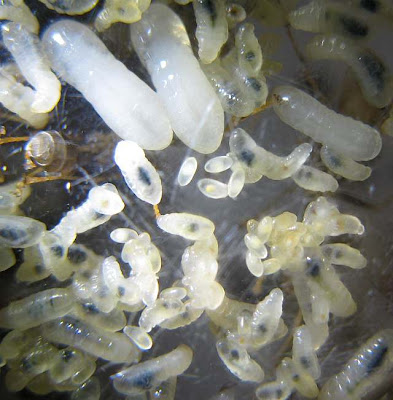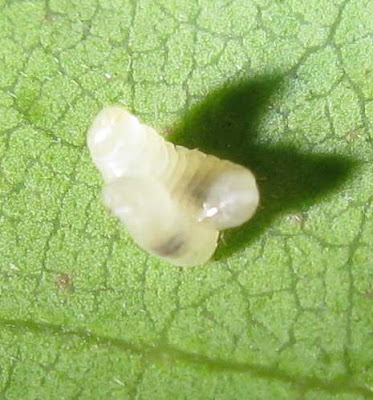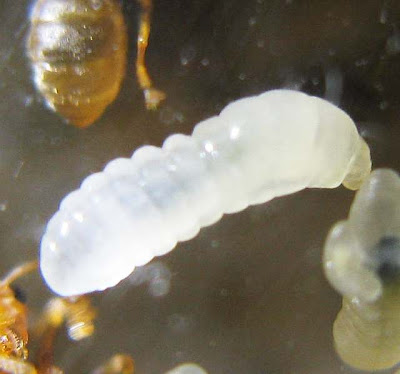Oecophylla smaragdina is a common red tree dwelling weaver ant. The color is not definitive of the species as there are also those which are green. Oecophylla smaragdina are group hunters and individual ants are mostly ineffective against live prey except very small ones.
This arboreal or tree dwelling ant is the only species of ant that has been used by mankind as an effective biological control agent against agricultural pest. In parts of Southeast Asia the grubs (larvae and pupae) of the female reproductives are also collected and sold in markets as a local delicacy.
The name smaragdina which means emerald comes from the green color of this ant species found in Australia. Over here in South Asia the local species is red in color (the workers). The queens (include female alates) though are mostly green, varying from dark to light green.
Oecophylla smaragdina nests can be quite extensive covering several trees over a hundred feet. These nests are made of leaves woven together with ants' silk secreted by the larvae. Some workers pulled leaves together while other workers each with a larva in its mandibles 'glue' the leaves together, with the ant silk secreted by these larvae, to formed a shelter where the brood are housed.
A typical colony may commonly have several of these leaves cluster nests spread over several trees. A large colony may have a foraging area of over a hundred feet with nests all along the trees (and shrubs-) that lined their foraging route.
Oecophylla smaragdina workers are dimorphic. It is among a few species of ants that practice true caste separation where the much smaller minor workers strictly tend to the nest and nest areas while the main foraging and hunting activities are carried out by the major workers.
This ant both bite and “sting” (by squirting formic acid from it gaster) reversing its gaster upwards and forwards towards its head instead of down and forward. It can also squirt droplets of formic acid from the end of its gaster which is mostly aimed at the eyes and noses of browsing cattle and goats. Oecophylla smaragdina like most species of the Formicinae subfamily do not have a 'functional' sting like other stinging ants.
Even as the hunting and foraging are carried almost extensively by the major worker, both major and minor workers of Oecophylla smaragdina tend to the brood as well as in nest defense. However only the major worker undertake territorial defense of their pathway and trees where they nest or harvest nectar and honey dew. The minor workers also undertake the collection of honey dew and plant nectar in the vicinity of their nests.
Like many tree dwelling ants, Oecophyla smaragdina establishes mutualistic relationship with many sap sucking insects and also with the caterpillar of some butterfly species. Some parasitic caterpillar species that feed on their brood are also harbored by Oecophylla smaragdina.
Even as the hunting and foraging are carried almost extensively by the major worker, both major and minor workers of Oecophylla smaragdina tend to the brood as well as in nest defense. However only the major worker undertake territorial defense of their pathway and trees where they nest or harvest nectar and honey dew. The minor workers also undertake the collection of honey dew and plant nectar in the vicinity of their nests.
Like many tree dwelling ants, Oecophyla smaragdina establishes mutualistic relationship with many sap sucking insects and also with the caterpillar of some butterfly species. Some parasitic caterpillar species that feed on their brood are also harbored by Oecophylla smaragdina.
Oecophylla workers 'weaving' a new nest. This is a fairly young nest and the workers have not attained to the full size of a mature nest.
A sub nest of Oecophylla smaragdina on a low hanging branch.
On sensing my movement as I focused to shoot a photo, all the workers rush out to the end of the leaf formed sub nest. This I suspect is a response against cows and goats.
Oecophylla workers collecting the sweet secretions of this leaf eating caterpillar of Hypolycaena erylus. This is a mutualistic relationship. The caterpillar gets protection from predators and reward the ants for the protection with a sweet sugary secretion.
Workers of Oecophylla attacking a bee mimicking moth.

Male alate of Oecophylla smaragdina.
Workers of Oecophylla attacking a bee mimicking moth.

Male alate of Oecophylla smaragdina.
The major and minor workers of Oecophylla smaragdina tending to the brood.
A normal major worker of Oecophylla smaragdina (above and below).
A minor worker of Oecophylla smaragdina grooming a major worker.
Minor workers of Oecophylla smaragdina are about half the size of the major workers.
A major worker of Oecophylla smaragdina holding a pupa.
Above and below workers of Oecophylla smaragdina tending the pupae. Unlike the larvae and eggs, pupae of Oecophylla smaragdina are not 'sticky' and are held together by the workers covering over them.
A minor worker of Oecophylla smaragdina with a pupa.
The baby looking minor worker of Oecophylla smaragdina.
Photo above and below shows the minor workers.
The queen or gyne of Oecophylla smaragdina viewed from top.
Lateral view of a queen or gyne of Oecophylla smaragdina.
Frontal view. The gyne is 17 millimeters long.
Oecophylla smaragdina gyne tending to her first clutch of eggs. Both the eggs and larvae of Oecophylla smaragdina are sticky and adhere to leaves' surfaces but not the pupae. Typically a newly mated alate gyne will make her way up a tree looking for a suitable leaf that have a concave curve to begin her new nest. Through instinct she will chose a fairly young leaf that has reached its full size. This leaf is typically near (but not at) the tip of the branch-lets. She typically chooses a leaf that is slightly curving downwards creating some sort of a concave hollow. She then settles on the underside of the leaf where she immediately lays her first clutch of some over twenty eggs. Within two days she would have laid slightly over thirty eggs. Oecophylla eggs hatching in four to five days is one of the fastest among mid size ants. The larvae growth rate is likewise quite fast (for ants of that size range) and they begin to pupate within a week to ten days and typically eclose around 25 to 26 days. The new queen uses the larvae to spin a nest of ant's silk as a tent to cover the whole area over where she is brooding. This nest 'tent' covering is crucial as the pupae is non 'sticky' and will not adhere to the brood clutch and would be easily blown off the nest by even a light breeze.
An Oecophylla smaragdina queen with her first clutch of eggs.
Whenever she detect motion the Oecophylla founding queen will try to make herself inconspicuous. Like most big to large ants especially those that are arboreal foragers, Oecophylla smaragdina are alert to movement within their proximity.
The Oecophylla smaragdina founding queen tending to her first brood.
Three days after the first batch of larvae hatched, the Oecophyalla smaragdina queen begins building her protective tent. Around 7 to 8 days after laying the first egg which takes around 4 (or more) days to hatch, the queen with her first batch of larvae begin weaving her tent of ant silk, a process that takes several days.
Following chemical cues from the larvae the queen select one that is ready to produce silk and began the construction of her protective tent.
The 'tent' building works usually takes several days.
Once a larva is momentary 'depleted' the queen will return her to the brood and picks up another larvae to continue the 'tent' building until she has thoroughly weave a water proof tent.
The Oecophylla smaragdina founding queen tending to her first brood.
Three days after the first batch of larvae hatched, the Oecophyalla smaragdina queen begins building her protective tent. Around 7 to 8 days after laying the first egg which takes around 4 (or more) days to hatch, the queen with her first batch of larvae begin weaving her tent of ant silk, a process that takes several days.
Following chemical cues from the larvae the queen select one that is ready to produce silk and began the construction of her protective tent.
The 'tent' building works usually takes several days.
Once a larva is momentary 'depleted' the queen will return her to the brood and picks up another larvae to continue the 'tent' building until she has thoroughly weave a water proof tent.
How the ant communicate with the larva in spinning the silk should be of particular interest. A genetic intelligence expressed is the larvae communicates with the ant possibly using chemical signals as the ant appeared to know which larva is ready to use and when to stop and switch to another larva.
The Oecophylla queen hiding under her tent. Oecophylla queens are semi-claustral. She will cut a small opening in her silken tent allowing her to venture out to get moisture.
The Oecophylla queen hiding under her tent. Oecophylla queens are semi-claustral. She will cut a small opening in her silken tent allowing her to venture out to get moisture.
The larvae soon transform into pupae.
Oecophyla smaragdina queen with her brood under her tent. Here the photo shows how critical it was for the queen to have her silken tent done as the pupa does not stick to the clutch or to surfaces.
The Oecohylla queen with her first worker. On the left there can be observed a small opening in the tent that allows the queen to venture forth for moisture.
The workers eclosed in 25 to 26 days. Typical of most ants the first few batches of workers are much smaller than those in mature nests.
Oecophylla smaragdina workers feeding on a piece of cooked chicken. By the 30th day the workers are actively foraging for food.
Around a month after the first batch of workers begins foraging and dependent on availability of food, the first full size worker eclosed. Image above show the size difference between the first batch and the full size worker.
Oecophylla smaragdina workers feeding on a piece of cooked chicken. By the 30th day the workers are actively foraging for food.
Around a month after the first batch of workers begins foraging and dependent on availability of food, the first full size worker eclosed. Image above show the size difference between the first batch and the full size worker.
The gyne is very protective of the brood and sits directly over them. Here only a larva is seen. Unlike nest of subterranean ants that are safely hidden in the underground craven or tunnel, all that stands between the brood and a predator of Oecophylla smaragdina is the gyne guarding them during the founding stage before the first larvae hatch and the first brood of workers eclose.
Sometimes for the first few months, new nests are found on the underside of leaves as there are insufficient larvae (and also workers to fold leaves) to weave together a proper nest (when the first leaf on which the queen established the tent nest dried out and drop from the tree) as the food gathering activities of the first batch of workers maybe unable to sustain the food requirement of the queen to produce a large enough quantity of eggs and the corresponding larvae to weave together new leaves for their nest. Minor workers do not appear until some three to six months later.
Eggs, and larvae of the weaver ant Oecophylla smaragdina in various stages of growth.
Close up of two young larvae.
A larva of Oecophylla smaragdina ceased feeding as it gets ready to pupate.
A larva of Oecophylla smaragdina at the peak of its growth.
The pupa of Oecophylla smaragdina.
The nest of Oecophylla smaragdina is made by weaving leaves together with ant silk secreted by the larvae.
The nuptial flights. The nuptial flights generally take place from early morning after the sun is fully up to around noon depending on the weather commonly (but not always) after a previous day/night of rain. A colony will (conditions being favorable) general release a nuptial swarming around every period of some thirty days or so. Nuptials are released all year round but peaked (the frequencies) during the raining season.
Extras
Oecophylla smaragdina is the easiest of ants to rear. All you need is a small container with a cover to house the newly mated queen. The cover is to keep the queen in until she lay her first clutch of eggs. After that the cover is no longer needed. Then just feed her with sugar water every other day to keep her and her brood hydrated. The queen will stay over her clutch of eggs until they hatch and then she will begin weaving the silken tent over them. If desired liquid protein feed with added sugar can be given to boost the brood.
Colonies can be kept at a manageable level by controlling the amount of protein feed. Here is a colony (I have) maintained at around fifty workers (for some eight months where wild colonies would by such time have several thousand workers) with just once a week or fortnight feed of a limited amount of protein food (usually insects and other arthropods but may include meat either cooked or uncooked).
Oecophylla workers typically suck dry any insects they caught and store the sucked dried insects for weeks to months. Basically they are one (may not be the only, as other weaver species may do similarly) ants that preserved their food by draining them of moisture.
Oecophylla also scent mark they territories (but not their nests) with their faeces. In this colony the (major) workers are darker in color than the minor workers.
A typical wild colony in an urban setting (areas with lines of trees planted along a road or beside a building) release some twenty queens each nuptial. This is commonly after rain has fallen or a day before. Swarming typically take place around once a month (plus a few extra days) and happens all year round whenever there is rain. Here are four mated queens collected (just before noon) along the corridor of a block or row of shophouses (where I stayed).
Oecophylla workers attacking a burning discarded cigarette
Over slightly a hundred meters of trees lining a sidewalk two Oecophylla colonies which used to lived peacefully for years avoiding one another all of a sudden are fighting. And the reason, four days of continuous rain has washed away their safeguard, the faeces mark territories that have keep them apart. Oecophylla colonies mark their territories with the faeces. These keep away other colonies and also prevent a mated queen from landing on a occupied tree. But the four days of rain has washed away their scent markings and without that the two colonies that used to coexist peacefully now find themselves at war.
The invaders
The war zone
The war zone
The War Zone
Two Oecophylla colonies in conflict (click on video to enlarge).
Forty-eight hours later, the losing side has retreated
leaving the invaders with a few casualty of the other side
on the base of the tree trunk.
Taxonomy:
No rank: cellular organisms 131567Superkingdom (Domain): Eukaryota 2759
No rank: Opisthokonta 33154
Kingdom: Metazoa 33208
No rank: Eumetazoa 6072
No rank (Subkingdom): Bilateria 33213
No rank (Branch): Protostomia 33317
No rank (Infrakingdom): Ecdysozoa
No rank (Superphylum): Panarthropoda 88770
Phylum: Arthropoda 6656
No rank (Subphylum): Mandibulata 197563
No rank: Pancrustacea 197562
Subphylum (Epiclass): Hexapoda 6960
Class: Insecta 50557
No rank (Subclass): Dicondylia 85512
Subclass (Infraclass): Pterygota 7496
Infraclass: Neoptera 33340
Cohort: Holometabola
Order: Hymenoptera 7399
Suborder Apocrita 7400
Infraorder: Aculeata 7434
Superfamily: Formicoidea
Family: Formicidae 36668
Tribe: Oecophyllini 84545
Genus: Oecophylla 84546
Species: smaragdina 84561
Updated: 2022 06 25
First Posted: 2010 04 19
© 2010 – 2022 Quah. All rights reserved.
© 2010 – 2022 Quah. All rights reserved.


































































